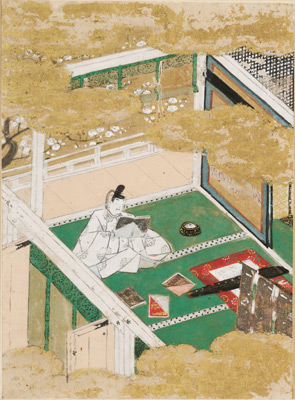Curators at the Harvard Art Museums are turning a new page this spring—in fact, several new pages. At least six objects in the galleries will have their pages turned in order to display different art, as part of our regular rotation of works. Among them is the Arthur M. Sackler Museum’s famed Tale of Genji Album, on view in the East Asian Art gallery on Level 2.
The Tale of Genji is an ancient Japanese work of literature, written in the early 11th century. Authored by a noblewoman known as Murasaki Shikibu, Genji is widely thought to be the world’s first novel. In 54 chapters, it tells the story of the romances of fictional prince Hikaru Genji. Though the prince’s amorous affairs usually end poorly, he remains the ideal romantic hero of the Heian period (794–1185). “He’s the ultimate heartthrob,” said Quintana Heathman, the museums’ curatorial fellow in Japanese art. “He’s beautiful, he’s sensitive, he’s poetic.”
By the 16th century, the novel had become a foundational work of Japanese literature, and knowledge of it was a form of cultural currency (that remains the case to this day). The museums’ Tale of Genji Album, created about 1509, is the world’s oldest extant, complete illustrated album-format edition of the work.
When the Tale of Genji Album first came to Harvard on loan in 1971 from rare book collector Philip M. Hofer (who later bequeathed the book to the museums), it was a double-sided, accordion-style album. Research by Harvard faculty, museums staff, and outside experts suggested that this object was a work of major significance, which led the Japanese government to select it for a special conservation project in the late 1990s. During conservation, inscribed backing sheets were discovered behind each album leaf, identifying the names of six prominent calligraphers and suggesting the pages may have once been displayed in folding-screen format. A medieval courtier’s diary provides further evidence that the prestigious artist Tosa Mitsunobu and six courtly calligraphers were involved. Conservators removed the backing sheets for future study and remounted the paintings and calligraphy into two large albums with single-sided pages for their protection. One of these albums is on view in the galleries today (you can see images of the other pages of this album here).
The first illustrations on display were Chapter 19’s Wisps of Cloud (Usugumo) and Chapter 20’s The Bluebell (Asagao). With the page-turning this month, the selected works will be Chapter 23’s The Warbler’s First Song (Hatsune) and Chapter 24’s Butterflies (Kochō). The latter chapter may resonate with snow-weary local visitors for its depiction of a springtime outing in the blooming garden of Genji’s greatest love, Murasaki.
“We are lucky to have a complete album of such high quality and in such wonderful condition,” Heathman said, “and we are thrilled to be able to share more of it with the public by turning the pages. I would encourage visitors to look not only at the paintings, with their gorgeous pigments and charming details, but also the calligraphy, which you do not need to be able to read to enjoy; it can be appreciated for its purely visual qualities as well.”




